Last Chance to Catch NYC's Holiday Notalgia Train
We met the voices of the NYC subway on our nostalgia ride this weekend!


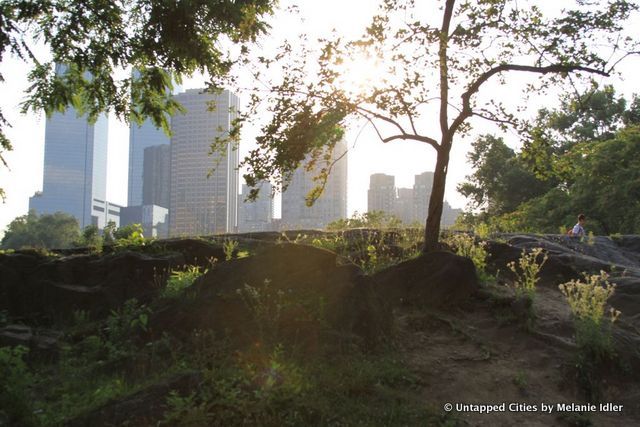
On June 18th, Landmark WEST! hosted one of its annual summer tours with Andrew Dolkart, professor of Historic Preservation at Columbia University’s Graduate School of Architecture, Preservation and Planning. For those who have not had the pleasure of attending one of Dolkart’s tours they are some of the most enjoyable as well as enlightening in the city. Dolkart’s tours are especially interesting because he weaves in his extensive knowledge of the quirks and changes in the development of New York City’s buildings, parks and neighborhoods. Along this tour we learned about how politics and courageous restoration efforts have helped shape and change the most famous of New York City’s parks over its 140 year history.
In The Grid exhibit at Museum of the City of New York, (check out our review of the exhibit book The Greatest Grid: The Master Plan of Manhattan 1811-2011) you can see that Central Park was not present in the plans of the city at the time of the park’s unveiling. As Dolkart explains, it was left out because in 1811 the city barely extended above Canal Street. One did not need to walk far in order to reach wilderness, so foreseeing the need for such a large park would have been deemed excessive. In this sense, Central Park is probably the best alteration that has been made to the Grid, and one that people today could scarcely imagine Manhattan without.
Central Park itself was not entirely wilderness, a small village called Seneca Village that may have had some of the first African American land ownership in the country existed between 82nd and 89th street on the western side. Ultimately the land was surveyed and was deemed unfit for large scale development, as well as an ideal location for parkland. Using eminent domain these original tenants were removed, and plans for a large scale public park began. In preparation for what would one day be the park, a committee placed Fredrick Law Olmsted as Superintendent, but without a design or plan he mostly oversaw a workforce of Irishmen who moved around boulders. After years of building steam, a competition was held to design a park in 1857. Olmsted and Calvert Vaux’s Greensward Plan easily won the competition (the other proposals may never have been considered says Dolkart), and the bold plan asked for a complete overhaul of the landscape from 59th to 110th Street.
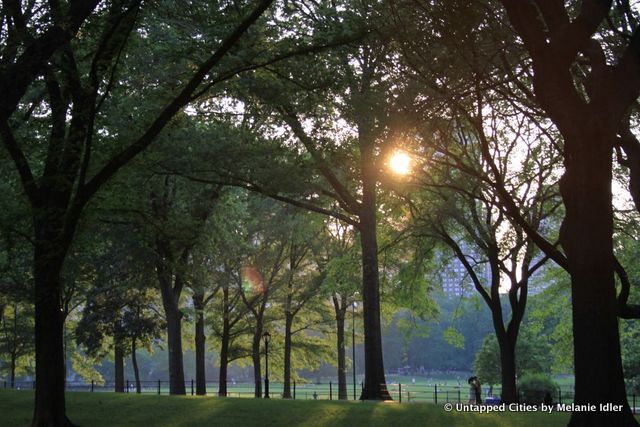
As construction commenced, over 13,500 cubic yards of topsoil was removed to New Jersey. Four million trees, plants and shrubs were planted, and stones protruding out of the ground were moved, stacked and altered depending on Olmsted’s vision on how they should shape and anchor the park. Thousands of workers carried out this work to create a completely artificial landscape, artificial being the key word. What is really great, Dolkart explains, is that Central Park may be the best example of an artificial interpretation of wilderness in America, the fact it goes unnoticed by the common park goer was completely intended by the designers, something that would greatly please them if they were still alive today.
In the book Waterfront, A Walk Around Manhattan Phillip Lopate writes that “Central Park was the stroke of genius needed to complete the grid, by offering a counterpoint of man-made Nature: the largest and greenest of rectangles, superimposed on the checkerboard.”
Our tour began at the entrance on 59th street and 5th, just north of the Plaza Hotel. Entering in to the park from this entrance is great for understanding the vision that Olmsted and Vaux had attempted to replicate throughout. As soon as you enter you descend into a little nook flanked by a nice grassy hill on one side and a pond on the other. The path in front of you curves around a small pond and forces you to choose which way you would like to go, each leading to a separate area of the park. This is characteristic of Olmstead; he wanted people to drift through the park and each section to feel different and separate from the last. Dolkart pointed out that the main things that make up the park, waterbodies, outcroppings, hills, open meadows, and small forests are scattered throughout for you to constantly explore and move from one to the next. Every piece is crafted to a particular vision, and the changes are representative of the politics at play during that time.
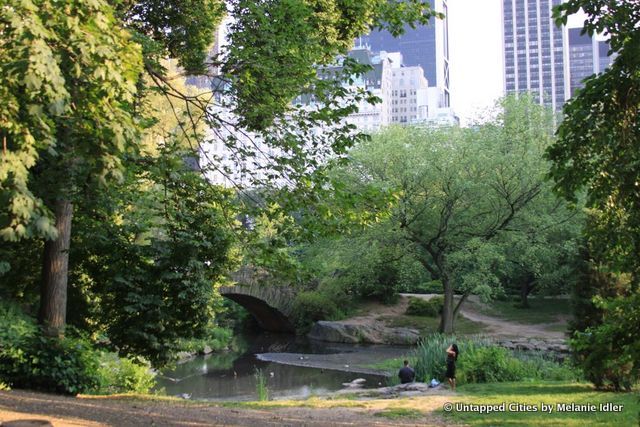
The pond at this entrance was one of the first places restored by the Central Park Conservancy, the park’s current caretaker. As longtime residents know the park experienced serious decline and neglect from the 50’s to the late 70’s. The pond was not properly draining and was filled with silt, a corruption of its original design. Its proximity to this key entrance made it an important location to be reclaimed, and it now blends much better with Wollman’s rink, an active infrastructure addition made by master planner Robert Moses. At the time Wollman’s rink was constructed it is possible most people didn’t even know who Olmsted was, or how far from his original vision Central Park was going. Moses’ additions were all active and hard infrastructure, like playground sets and volleyball courts. None of these were originally envisioned by Olmsted, and they tell a different story of where New York was in the 1940’s as opposed to the 1860’s.
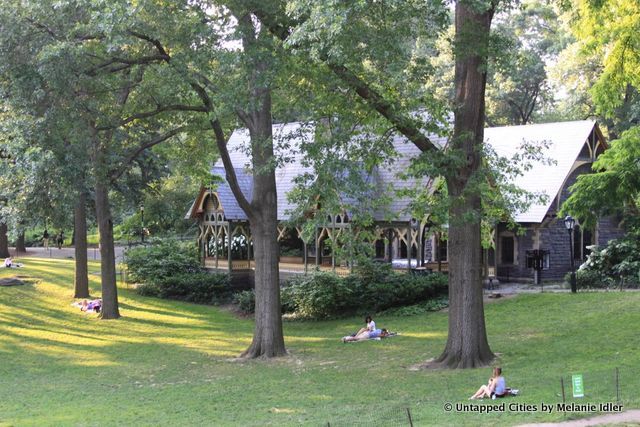
The second landmark we learned about on the tour was the restored Dairy Building. Designed by Vaux, the building was important for the anticipated families that would enjoy the park. At the time of the park’s construction, high rates of death in children were attributed to bad milk, which was unpasteurized at the time. After pasteurization was developed the structure was converted to a small restaurant which closed in the first decades of the 20th Century. By the 1950s the building was essentially abandoned and dilapidated. Vaux’s neo gothic structure had become rotted and lost most of its paint. After being left forgotten for two decades, the Central Park Administration and CPC hired a design team to restore it. The design team only had black and white photographs of the building from the turn of the century to assist their restoration effort. Coincidentally, the original Dairy Barn plans, along with tons of other original architectural sketches and documents (with color schemes) were discovered in a warehouse in Brooklyn just as they were beginning their work. With this treasure trove of municipal documents they were able to properly restore the Dairy to Vaux’s vision and it was reopened in 1979 it as the Park’s first visitor center.
As I have come to learn, great infrastructure or designs are the ones you hardly notice. In Central Park, the original paths did not cross each other. Instead, carriage lanes extended above pedestrians lanes with 36 unique, beautifully designed bridges, and the four designated traverse roads were conspicuously concealed below the main grade of the park to carry traffic from the East to the West Side. Olmsted complimented the grid of Manhattan by creating a park with no intersections; any at grade crossing are recent changes. Dolkart also gave a quick stop to explain the geology of the Park. The visible rocks that pierce through the parks grounds are Manhattan Schist, the bedrock Manhattan is famous for and that allows us to build skyscrapers. The majority of the rock outcroppings of Central Park are as artificial as the lakes, forests and buildings, with many of them being moved under Olmstead specifications. The tell-tale sign of an original rock is if the lines of the rock are traveling north-south along the surface, a signature of the geological process that created them.
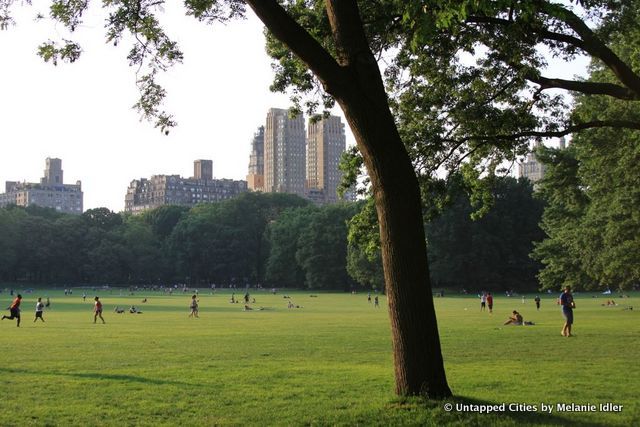
Continuing north through the park we explored Sheep’s Meadow and the Promenade. The placement of these areas next to each other is interesting, because the sheep meadow is carefully designed to appear as a natural, open rolling meadow, whereas the promenade is the most formally designed section of the park, with a straight walkway running right down the middle (but not parallel to the grid of course!). The Sheep Meadow did contain sheep, which had to be moved in the 1930’s for fear of being eaten by Depression-era residents. The meadow hosted numerous concerts and Be-Ins in the 1960’s, supported by Mayor John Lindsay which led this section to lose most of its grass and some of the surrounding trees. To restore it the CPC put up a fence and shut the area off for an entire year to allow it to seed. Although reopened to the public, much of the fence surrounding the meadow remains, as does the debate on whether it should still be there.
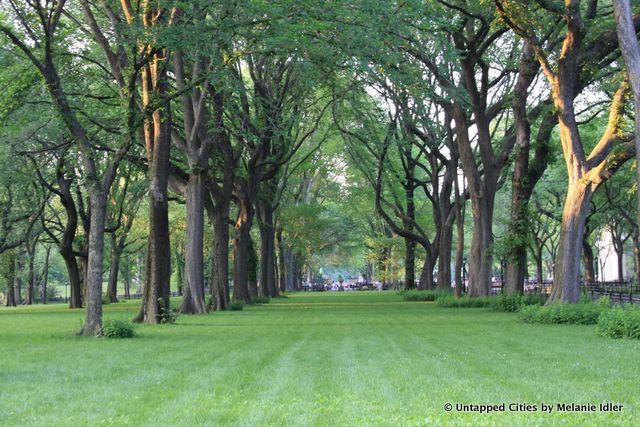
By crossing an unfinished road that became a volleyball court you enter the Promenade. Covered with exquisite benches, large bronze statues, and a sectioned off elm grove this is one of the most unique sections of the park. The bronze statues are not within the vision of Olmsted and Vaux, who believed that once you started allowing monuments for men to be placed in this setting, what is to stop them from putting a statue to anybody in? Those fears were somewhat realized in the building of this section, however as Dolkart points out it could be argued that this section contains some of the best and worst sculptures and monuments in a public park. This is all set against a majestic and serene grove of Elm Trees. The American Elm is one of the great trees that city planners and architects across America used to create wonderful canopies of tree lined streets.
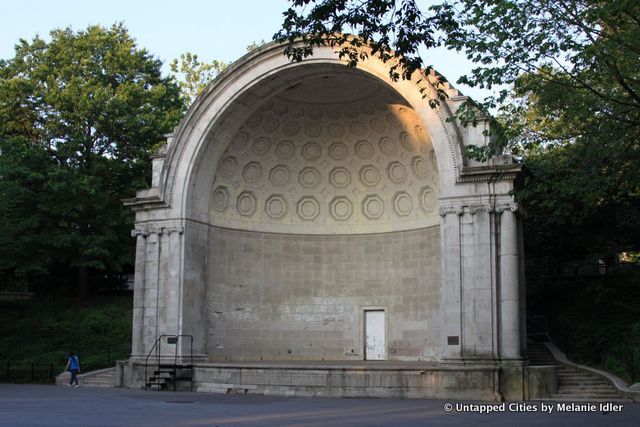
At the northern end of the promenade is the Naumburg Bandshell. The wealthy banker, philanthropist and music enthusiast Elkan Naumburg donated funds to replace a declining wood and cast iron bandstand with this Beaux-Arts style limestone bandshell. The bandshell hosted numerous events and musicians before falling into disrepair and was covered in graffiti. There were talks to demolish the structure entirely when deterioration continued until the grandson of the original donor used the legal system to fight its destruction. Although in limbo, preserved but not fully restored, the bandshell still hosts free concerts which it has done since 1926, a lovely continued presence next to the contemporary Summer Stage.
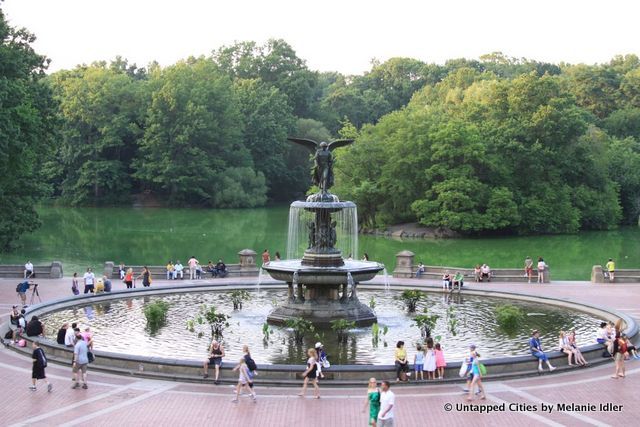
Our final destination was the Bethesda Fountain and Terrace, arguably (and supported by Dolkart) to be the heart of Central Park. The falls look out over a nice arm-like extension of the Lake, flanked by where the original boathouse was located. Between the top of the stairs and the edge of the water lies the Angel of Waters sculpture by Emma Stebbins. Designed after a scene in the Gospel of Saint John where an angel gives healing powers to the Pools of Bethesda. This symbolism was so strong that it inspired Tony Kushner’s Aids epidemic play Angels in America. Lining the stairs are some of the most beautiful terra cotta ornamentation in a park setting, with different sections representing the four seasons, including bees for spring, and the harvests for fall. Like our previous stops, this area was also restored by the Central Park Conservancy after it had been a drug haven in the 1970’s. This was one of their centerpiece campaigns in the 80’s, and the scene today makes it difficult to imagine it as a drug market, clearly the regenerative powers of the fountain apply to the park itself and not just to the people.
Throughout this tour we learned about the growth, decline and resurgence of Central Park, which mirrors a similar trajectory the city has experienced. Yet somehow, despite all the change, reconstruction, and restoration, the park clearly succeeds at its original vision of providing open space, air, sunlight and sanctuary for the common people of the city. It’s easy to argue there is no better way to spend a summer afternoon than exploring the nooks and crannies of Central Park. What I learned on this tour is that every section, every hill, every sculpture, every tree and every stone has a complex history. Next time you visit friends or on a date and are strolling along the curvilinear roads or stately bridges in Central Park; make sure you point out that rocks with north-south lines are the only original landscapes, I am sure it will score you some serious New York street cred.
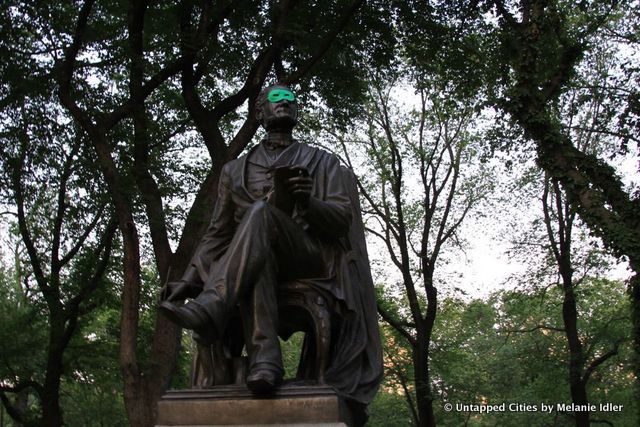
Subscribe to our newsletter